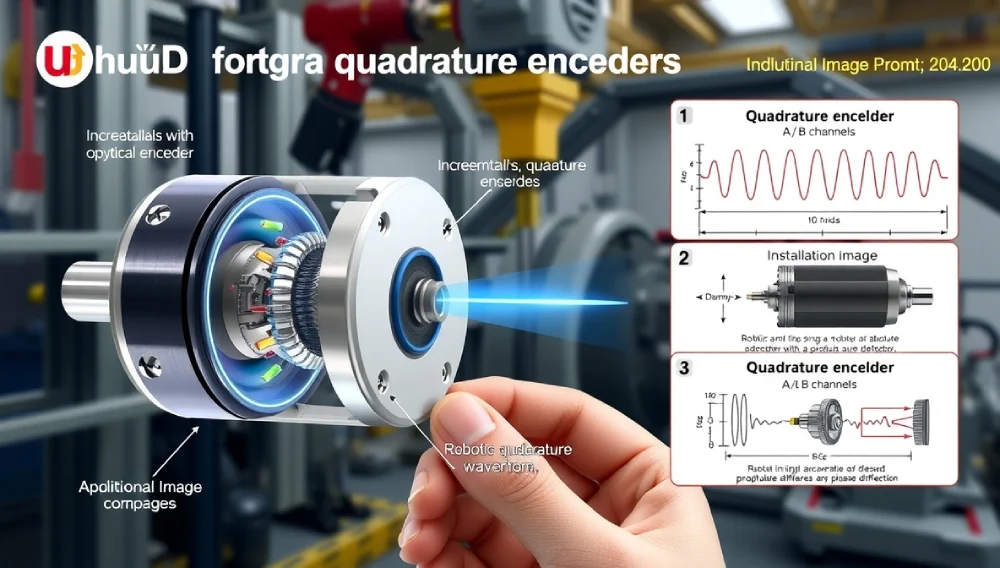Quadrature encoders are essential components in modern automation, robotics, and motion control systems. Whether you’re a beginner exploring the basics or a professional looking for advanced insights, this guide will walk you through everything you need to know about quadrature encoders. We’ll cover how they work, their applications, product recommendations, and a buying guide to help you make the best choice.

Amazon Newest Arrivals $ 18.99
What is a Quadrature-Encoder?
A quadrature encoder is a type of rotary encoder that converts the angular position or motion of a shaft into digital signals. It’s widely used to measure speed, direction, and position in various applications, from industrial machinery to consumer electronics.
How Does a Quadrature-Encoder Work?
Quadrature encoders use two output channels (A and B) that produce square wave signals. These signals are 90 degrees out of phase, which is why it’s called “quadrature.” By analyzing the phase relationship between the two signals, the encoder can determine:
- The direction of rotation: Which signal leads (A or B) indicates the direction.
- Position: Counting the pulses gives the position of the shaft.
- Speed: The frequency of the pulses determines the speed.

Applications
Quadrature is versatile and used in a wide range of industries. Here are some common applications:
- Robotics: Precise control of robotic arms and joints.
- CNC Machines: Accurate positioning of tools and workpieces.
- 3D Printers: Monitoring the movement of print heads and build platforms.
- Automotive: Measuring wheel speed for anti-lock braking systems (ABS).
- Consumer Electronics: Tracking the rotation of knobs in audio equipment.
Read HDMI’s technical details on Wikipedia
Explore AMS’s comprehensive quadrature encoder solutions at ams.com.
Types
There are two main types of quadrature:
- Incremental Encoders: These provide relative position data by counting pulses from a starting point. They’re ideal for speed and direction measurement.
- Absolute Encoders: These provide unique position values for each shaft angle, even after power loss. They’re perfect for applications requiring precise position tracking.
Explore IEEE standards for encoders
Product Recommendations
Here are some popular encoders with their pros and cons:
1. US Digital E4P Miniature Optical Encoder
- Pros:
- Compact and lightweight.
- High resolution (up to 2,500 CPR).
- Easy to install.
- Cons:
- Slightly higher price point.
- Limited to incremental encoding.
2. Omron E6B2-CWZ6C Rotary Encoder
- Pros:
- Durable and reliable.
- Affordable.
- Compatible with a wide range of applications.
- Cons:
- Lower resolution compared to premium models.
- Requires careful alignment during installation.
3. Broadcom AEDR-8300 Reflective Optical Encoder
- Pros:
- High resolution and accuracy.
- Small form factor.
- Suitable for high-speed applications.
- Cons:
- Sensitive to dust and debris.
- More expensive than the basic models.

Buying Guide
Choosing the right quadrature encoder depends on your specific needs. Here’s a step-by-step guide to help you decide:
1. Determine the Resolution
Resolution is measured in counts per revolution (CPR). Higher CPR means more precise position tracking. For example:
- Low CPR (100-500): Suitable for basic speed measurement.
- High CPR (1,000-10,000): Ideal for precision applications like CNC machines.
2. Choose Between Incremental and Absolute
- Incremental Encoders: Best for speed and direction measurement.
- Absolute Encoders: Necessary for applications requiring exact position tracking.
3. Consider the Environment
- Dusty or Wet Conditions: Opt for encoders with IP ratings for protection.
- High-Speed Applications: Choose encoders designed for high RPMs.
4. Check Compatibility
Ensure the encoder is compatible with your system’s voltage, output type (TTL, HTL, etc.), and mounting requirements.
5. Set a Budget
Prices vary widely based on features. Determine your budget and prioritize features that matter most to your application.
Experience
As someone who has worked with encoders in both hobbyist and professional settings, I’ve found them to be incredibly reliable and versatile. For example, while building a custom CNC machine, I used the US Digital E4P encoder for its high resolution and compact size. It performed flawlessly, even during high-speed operations. However, I did notice that dust accumulation affected its performance over time, so regular maintenance was necessary.

FAQs
1. What’s the difference between a quadrature encoder and a regular encoder?
A quadrature encoder uses two output channels (A and B) to determine direction and position, while a regular encoder may only provide speed or single-channel position data.
2. Can I use a quadrature for speed control?
Yes, quadrature encoders are excellent for speed control because they provide precise pulse data that can be used to calculate RPM.
3. How do I troubleshoot a faulty quadrature?
- Check the wiring and connections.
- Ensure the encoder is properly aligned.
- Clean the encoder to remove dust or debris.
- Test the output signals using an oscilloscope.
4. Are quadratures waterproof?
Not all quadratures are waterproof. Look for models with an IP rating if you need water resistance.
5. What’s the lifespan of a quadrature-encoder?
The lifespan depends on the quality and usage conditions. High-quality encoders can last for millions of cycles with proper maintenance.
Conclusion
Quadrature encoders are indispensable tools for precise motion control and position tracking. Whether you’re working on a DIY project or a high-end industrial application, understanding how they work and choosing the right one can make all the difference. By following this guide, you’ll be well-equipped to select, install, and maintain a quadrature that meets your needs.
If you’re just starting out, I recommend trying the Omron E6B2-CWZ6C for its affordability and reliability. For more advanced applications, the US Digital E4P or Broadcom AEDR-8300 are excellent choices. Happy building!
Read More: Linear Encoder


1 thought on “The Best Quadrature Encoder 2025”